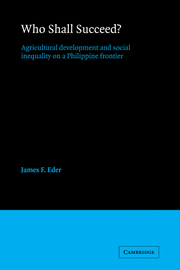Book contents
- Frontmatter
- Contents
- List of tables, figures, and maps
- Preface
- 1 Introduction
- 2 Rich man, poor man: life in a frontier farming community
- 3 The economic and social origins of the migrant farmers
- 4 Eight migrants
- 5 The origins of social inequality
- 6 The maintenance of social inequality: earning a living
- 7 The maintenance of social inequality: earning prestige
- 8 The perpetuation of social inequality?
- 9 Conclusion
- Appendixes
- A The measurement of social status
- B Costs and returns in agricultural production
- C The distribution of wealth and income
- Notes
- Bibliography
- Index
A - The measurement of social status
Published online by Cambridge University Press: 23 May 2010
- Frontmatter
- Contents
- List of tables, figures, and maps
- Preface
- 1 Introduction
- 2 Rich man, poor man: life in a frontier farming community
- 3 The economic and social origins of the migrant farmers
- 4 Eight migrants
- 5 The origins of social inequality
- 6 The maintenance of social inequality: earning a living
- 7 The maintenance of social inequality: earning prestige
- 8 The perpetuation of social inequality?
- 9 Conclusion
- Appendixes
- A The measurement of social status
- B Costs and returns in agricultural production
- C The distribution of wealth and income
- Notes
- Bibliography
- Index
Summary
The backgrounds, economic circumstances, association patterns, and other attributes of San Jose residents discussed in the text were all correlated with their positions in a status order whose principles were independently derived. Here I explain how I constructed the scale representing this status order. First I describe the status rating procedure; then I show how I combined the separate status ratings in a single composite status distribution along which I distinguished three analytical strata for sampling purposes.
The rating procedure
I obtained the raw data necessary to construct a scale of social inequality by asking a panel of nine status raters to make separate status placements for each family in San Jose. The only qualifications I imposed on rater selection were that the raters not be newcomers to the community and that they represent all socioeconomic circumstances. In addition, I chose persons that I knew fairly well and had found open and frank in previous interviews. I interviewed each rater separately but in the same manner. I first introduced the general idea of inequality using a standard, noncommittal introduction: Maski sadin ka magpakon, beke' parariho ang mga tao, maski digi sa San Jose, “Anywhere you go, people are not the same, even here in San Jose.” I then went on to say that one could usually visualize such differences in terms of groups, using hand movements to indicate that these groups might be arranged higher and lower.
- Type
- Chapter
- Information
- Who Shall Succeed?Agricultural Development and Social Inequality on a Philippine Frontier, pp. 208 - 216Publisher: Cambridge University PressPrint publication year: 1982

